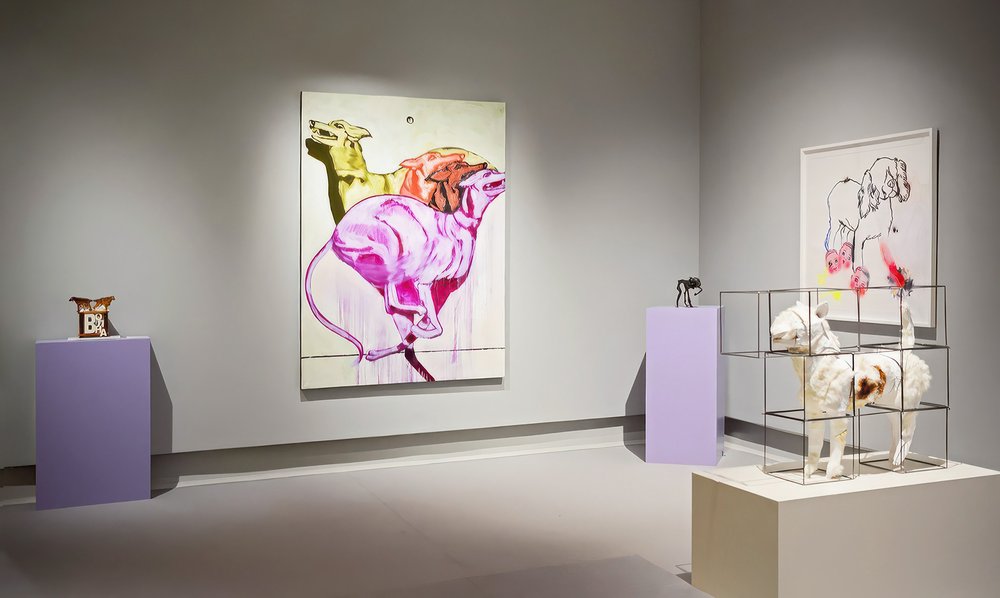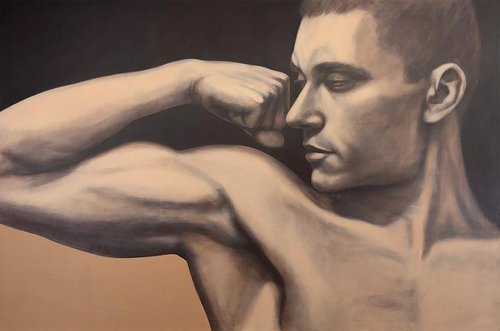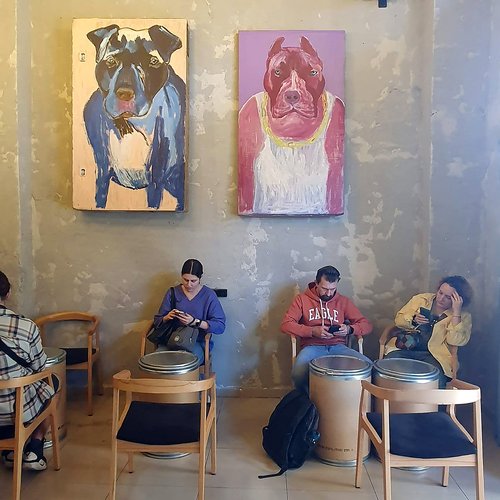Museums – Beware of the Dog!

The Life of Remarkable Dogs. Exhibition view. St Petersburg, 2025. Photo by Evgeny Eliner. Courtesy of The State Russian Museum
A novel exhibition in St Petersburg called the ‘Life of Remarkable Dogs’ challenges traditional curatorial approaches. Amid this sprawling display of man’s best friend, in over four hundred works made over several centuries, one work of art even came to the attention of the censors – and spawned an impromptu show elsewhere in the city which had sharper claws.
Renowned for being the largest collection of national art in the country, over the past few years the State Russian Museum has staged a slew of rather predictable, conservative themed shows – until now and its ambitious ‘Life of Remarkable Dogs’ which appears to buck this steady trend.
A bit of historical context for international readers: in the past Russian artists like Vladimir Favorsky (1886–1964) or Alexander Tishler (1898–1980) would draw a small dog in the corner of a painting in order to distract overzealous censors or committee from more controversial messages in the work. Soviet directors and playwrights frequently resorted to this tactic, intentionally sacrificing some doomed detail in the hope of preserving those stickier moments in films or theatrical productions, such as hints at sex or ideological polemic.
Today you might wonder if the Russian Museum is doing something similar, by filling the entire and vast Marble Palace with small dogs. Such a popular and much-loved canine subject easily overshadows the elephant in the room: the impossibility of currently working on any more serious, challenging exhibitions. It even temporarily puts the Ludwig Museum’s iconic collection of Russian contemporary art into the shade.
The title ‘Life of Remarkable Dogs’ references a famous series of books ‘Lives of Remarkable People’, and as a sort of literary prequel there are curatorial texts written by staff from the Department of Contemporary Trends at the Russian Museum: ‘Art History for Dogs’ (2012) by Alexander Borovsky; ‘Stories about Jerinka’ (1997) by Ekaterina Andreeva and ‘Soviet Space Dogs’ (2014) by Olesya Turkina.
When you enter the exhibition space, you quickly dive into the subject encountering some of Russia’s greatest artistic masterpieces – all of which turn out to have dogs in them. There is the greyhound called Zemira depicted standing faithfully beside the towering figure of Catherine the Great in an iconic portrait of 1794 painted by Vladimir Borovikovsky (1757–1825). Here the dog is a kind of elegant accessory to her silk gown as Zemira gazes fondly into the eyes of her powerful mistress, the whole effect bathed in sentimentalism. A little Bolognese which belonged to Elena Naryshkina as a child, also painted by Borovikovsky in the 1790s has a similar nuance. In this historical imperial epoch artists had to both convey the social status of their sitters as well as speak the language of allegory, and dogs were perfect as an aristocratic attribute and as a symbol of loyalty and devotion. Elsewhere, however, irrespective of class, dogs also supported their masters in genre painting like the naughty dog in ‘Brother-Tutor’ by Alexei Bobrov (1844–1917), the poodle in the iconic ‘Aristocrat’s Breakfast’ by Pavel Fedotov (1815–1852) who appears to be more refined than its owner, and dogs wearing costumes in Leonid Solomaktin’s (1837–1883) ‘Wandering Musicians’ who seem to endure far more hardship than their poor creative fellow humans.
Throughout the exhibition as you move from one space to the next you see little furry hounds comfort, accompany, serve, hunt, and perish in the name of us humans. They do not bark or bite rather they decorate beautiful interiors and diligently support artistic compositions, to the point of servility. The exhibition is curated with such a light, consistency that visitors might even start to believe in a whole life lived amongst dogs and get the feeling that every milestone of Russian art is marked by a canine presence.
‘Life of Remarkable Dogs’ switches attention with surprising ease from well-known and distinguished faces of Russia’s cultural and historical elite, like opera singer Fyodor Chaliapin, Prince Felix Yusupov, and artist Alisa Poret to the French bulldogs Roika and Gugus, a marble dog from the vestibule of the Arkhangelskoye Museum-Reserve, the many-faced Great Dane Hokusavna and several hundred other tailed and furry characters. Ultimately, the ambitious scale of this exhibition does it no great favours because despite their undisputed artistic qualities and memetic potential, soon all the paintings on the walls merge into a chaotic doggerel. Here a vague transhistorical approach where the curators mix works from different epochs unfortunately does not create any interesting visual rhymes. If attaching a tag to each work like Canine Good Citizen to give the breed or mongrel status of the dog a cynologist has turned the exhibition into a kind of game, it does not add any depth of meaning.
Roving through dog after dog, up on the third floor you eventually come to the contemporary art section which is assembled around themes like ‘Folk Toys’, ‘Children's Illustration’ and ‘The Heroic Dog’. Here the works of Olga Florenskaya (b. 1960) play an important role illustrating each category or chapter with her textile collage ‘Sedov's Dog’ (1986), the taxidermist object ‘Heroic Dog Laika in Space Aircraft’ and ‘Working Stuffed Dog of Pavlov’ (both from 1999), as well as soft toys depicting imaginary dogs from the project ‘Movement Towards YYE’ (1995), and ‘Military Signal Dog with Field Telephone and Shell Box’ (1998), which she created together with Alexander Florensky (b. 1960).
Amid the seemingly endless depictions of man´s proverbial best friend, there are some glaring omissions. There are no works from the ‘New Anthropology’ project in Koltushi, a lab and art & science museum near Saint Petersburg and specifically there no mention of the important site-specific installation ‘Waiting’ by Ludmila Belova, where memories of Ivan Pavlov's laboratory are a point of bioethical reflection. There is no photo documentation of performances in St Petersburg's Museum of Hygiene or key historical performances and actions by Moscow artists. Bizarrely, there is no mention of Oleg Kulik (1961) ’s wild dog alter ego performance and action, an iconic decade defining work. Here the works on display in the contemporary section are for the most part free of any possible conflict, decorative and toothless, even when there is in places an attempt to depict a snarl.
One work was even censored. Artist Valery Grikovsky (b. 1975) had been commissioned to make a new work for the show, an artist known for cutting up drawings on paper or painted canvases and placing the fragments in a box. Yet his ‘Introduction to the Theory of Evolution’ did not meet the approval of the museum staff who asked for changes to be made and ultimately refused to exhibit it after the artist resisted. Apparently, the fuss was all around the fact that the dog looked too sad – and it is true, there is definitely a lack of cheer in its furry face. According to the artist, the work was inspired by a statement by renowned Austrian ethologist Konrad Lorenz, author of ‘Man Meets Dog’ and ‘So-called Evil: On the Natural History of Aggression’. Lorenz once remarked: “I thought for a long time about where the missing link between ape and man was, until I finally realized: we are that transitional link”. Grikovsky’s canine creature, reminiscent of Sharikov from Bulgakov's ‘Heart of a Dog’, seems to exist precisely between instinct and learned helplessness. It also echoes “lonely dog looking into eyes” from the dictionary of Moscow conceptualists by Vadim Zakharov (b. 1951). This term is defined as a “split personality, where both are observing, but where the personality in the form of a dog understands something, whilst the personality in the form of a human has never understood, felt, or lived anything”.
Grikovsky contacted artist and curator Alexander Dashevsky and it sparked off a new project ‘SOS. Salon of Rejected Dogs’ at NeNeMu (the name of this micro institution sounds a bit polemical with regard to the Russian Museum and sympathetic to Mumu, a dog belonging to Gerasim, the mute in Russian classic Ivan Turgenev’s eponymous story. The modest exhibition space of NeNeMu itself which is a semi-basement room in the studio of artist Ruben Monakhov (b. 1970) prompted conversations about homeless dogs thrown onto the street, exiles and outcasts, marginal subjects ready either to desperately snap back or to humiliatingly and submissively obey anyone.
This impromptu ‘SOS’ exhibition lasted for only two days yet demonstrated a far broader range of metaphorical readings of the image of a dog than its earnest elder cousin at the Russian Museum. In Fyodor Hiroshige’s (b. 1982) wooden object from the series ‘Bark Around Kailash’ (2018), mythological layers intermingle – the Japanese yokai, a nine-tailed fox called kitsune, meets here with Cerberus, guardian of the realm of the dead. Sergei Tikhonov’s (b. 1983) dogs are actually expressive ‘Wolves’ (2015). Vladimir Kozin’s (b. 1953) installation ‘Troika’ (2011) from the series ‘To Everything Its Season’ contains an allusion to the eponymous 1866 canvas by Russian realist painter Vasily Perov (1834–1882). The exhibition at the Russian Museum includes his ‘Hunters at Rest’ (1871), yet the little dogs of genuine critical realism remain unaccounted for – in his oeuvre Perov painted so many of those that a curator could assemble an independent exhibition on this subject alone.
At ´SOS´, artist Semyon Motolyanets (b. 1982) showed a portrait of his ‘toxic’ character Ivan Dog from the 2010s and some photo documentation relating to the performance ‘Wolf in Sheep’s Clothing’ (2014) that took place in Gyumri. These are not the only works dedicated to dogs by an artist perhaps best known for working with soap. In fact, soap and dogs are connected in his art. Motolyanets recalls that as a kid he was struck by how when corpses of dogs were sent for processing people would swap them for pieces of household soap. For a large dog they gave six pieces of soap, for a smaller one – four. This impression stuck so firmly in his memory that even now smells have certain associations for him – dogs remind him of soap, and soap – of dog fat. Together with Dmitry Petukhov Motolyanets initially developed this theme as part of the art group Soap and later in other solo projects.
Ivan Govorkov (b. 1949) was represented at the ‘Salon of Rejected Dogs’ by canvases from the series ‘Golden Border’ (2020s), executed in a cold, operating-room palette. ‘Dog Biting Its Own Tail’ refers to the image of the ouroboros, whilst ‘Devotion’ a dog licking a giant fist is all about perverse loyalty. The latter work was placed in NeNeMu's most intimate space, the ‘fountain’ hall, that is, the lavatory. Finally, there was ‘Bitch’ (2025) by Misha Marker (b. 1987), a painted version of a poster the artist put up during a street intervention. A cute blue dog with the inscription ‘I understand everything – I cannot speak’ illustrates so-called dog syndrome, lifted from the practice of translators and editors, wrestling with the ever-present problem of choosing a word to the public at large forced to manoeuvre between self-censorship and external pressure. This stark image perhaps best sums up both ‘canine’ exhibitions and our dog’s life in general.
















